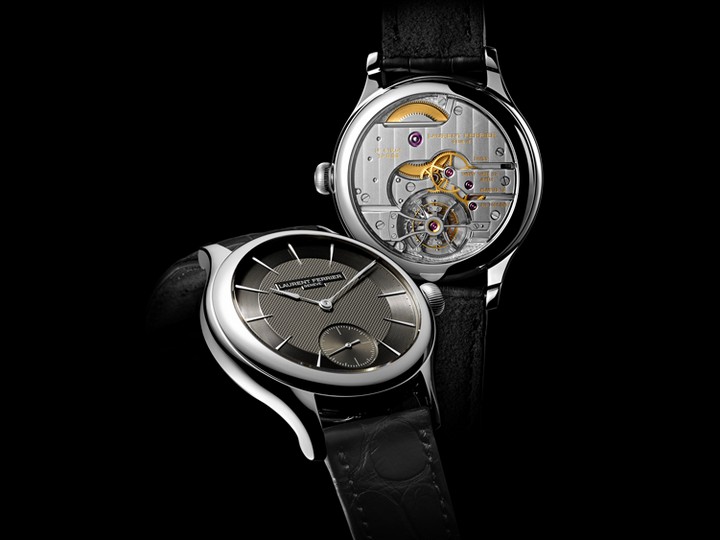
Six complicated timepieces that seem deceptively simple
A sleeper watch may seem understated but it conceals a highly complex overall package.
Related articles
A sleeper watch may have the external attributes of something simple and understated, but the outward appearance of this two- or three-handed timepiece conceals a highly complex (and often equally expensive) overall package. Flip a sleeper over and you have turned a coin; complication and horological extravagance abound, concealed by a sober and elegant dial.
In other words, a sleeper is the watch equivalent of the Audi RS4, which looks like a perfectly attractive dog-walker’s car of choice when in fact it’s a growling track weapon. The sleeper isn’t something that merely looks cheap but is actually expensive; rather, it is something that looks simple but is surprisingly complex. That complexity flies under most radars — enthusiasts with more than a passing interest in watches — yet it packs some serious horological firepower.
The Patek Philippe Ref.5078

A minute repeater is the ideal complication for a sleeper watch: high horology complication, no dial-indicator requirements, and a subtly positioned slider on the case band. The Patek Philippe 5078 is a minute repeater that almost passes for an entry-level 38 mm Calatrava, especially when the slider is concealed beneath a cuff. On closer inspection, one might notice the enamel dial, and the game is certainly upped when the slider is activated: On command, two hammers strike two gongs to indicate the time in a sequence of hours (first tone), quarter hours (second and first tone), and minutes (second tone).
The A. Lange & Söhne Richard Lange Pour le Mérite

The A. Lange & Söhne Richard Lange Pour le Mérite (US$82,500 ($A105,400)) has a similar, refined look to that of the 5078; it’s perhaps even more subtle as it lacks a slider on the case band to hint at its sleeper status. This is not a chiming watch, and there are no additional indications — so what makes the Richard Lange Pour le Mérite so special?
Flipping any A. Lange & Söhne over is a treat; its details include a German silver three-quarter plate, a hand-engraved balance cock, and gold screw-down chatons for the jewels. But there is even more to this model: Small areas of the plate give way to reveal something more complicated. Indeed, those familiar with the brand may know that any watch with Pour le Mérite in its title will be armed with a fusée and chain mechanism. This is a highly complex solution to the issue of diminishing mainspring torque; the mainspring barrel is attached to a fusée cone wheel by a string of tiny links that resemble a bicycle chain. In the same way that a bicycle uses its chain to engage with different gears, the level of torque required to turn the cone diminishes as it unravels, countering the declining torque. It’s an age-old mechanism but is highly complicated for a wristwatch.
What makes the Richard Lange Pour le Mérite even more complicated is that the cone wheel uses planetary gearing to ensure that the watch runs undisturbed during winding. It employs two lever mechanisms to prevent overwinding and to halt the movement before power levels drop below optimal. This complexity is hard to convey visually and even harder to do so with words — the perfect sleeper.
The Moser & Cie Endeavour Perpetual Calendar

A perpetual calendar complication is most commonly displayed via two or three subdials for the day, date, and month. The telltale sign that a watch has a perpetual calendar complication (as opposed to an annual or complete calendar) is the leap-year indicator. This format is most common across the few brands able to produce a perpetual calendar, and while they are often presented elegantly, these are not simple-looking watches.
However, when H. Moser & Cie released its clean-dialed Endeavour Perpetual Calendar (US$60,000 ($A76,650)), the perpetual calendar sleeper was born.
On first glance, the Endeavour Perpetual Calendar conveys elegant simplicity with a sub-seconds dial and large date. On second glance, the reserve indicator at 9 o’clock becomes apparent. But the small third hand at the centre of the dial might go unnoticed, or will at least give little away as to its function. This hand indicates the month, with each hour register representing January (1 o’clock) to December (12 o’clock). The leap indicator is discreetly placed on the movement side, allowing it to be referenced on the few occasions that it is needed.
In the spirit of a sleeper, the Endeavour Perpetual Calendar appears simple when it is actually quite complicated — even down to the large date beneath the dial; you will notice that no single disc could deliver numbers of that size within the diameter of the case. The entire mechanism has been made foolproof by allowing the date to be changed forward and backward without causing damage to the delicate series of cams and star wheels that govern a perpetual calendar.
The Laurent Ferrier Galet Classic Tourbillon

There is a growing number of watch manufactures capable of creating a tourbillon — a significant and complicated undertaking in its own right. However, this list drops to just a handful when you filter it for watches with tourbillons that are concealed beneath a full dial; plus, there are almost no manufactures that go as far as to both conceal the tourbillon and restrain themselves from writing ‘Tourbillon’ on the dial.
With the more commonplace Galet Classic Tourbillon Double Hairspring (CHF 180,000 for the gold version), Laurent Ferrier prints “Tourbillon Double Spiral” in faded ink on the enamel dial, but it’s the Clou de Paris Guilloché Dial iteration that achieves full sleeper status. This time-only watch in white gold makes no mention of a tourbillon on its hand-guilloché dial — and this is no ordinary tourbillon. As with its wider range of tourbillon watches, Laurent Ferrier uses two hairsprings to “neutralise the lateral displacement of the balance axis.” This is more complicated and more understated than your average tourbillon — a true sleeper.
Other notable sleeper tourbillons include the Voutilainen Piece Unique Tourbillon Wristwatch, which uses a detent escapement (highly unusual in a tourbillon), and the F.P. Journe 30 Years Anniversary Tourbillon, which conceals the tourbillon even more behind a solid, hinged caseback.
The Philippe Dufour Duality

The Philippe Dufour Duality is one of the rarest sleepers, as it’s no longer in production and only nine examples were ever produced. The 34-mm white-gold case, silver dial, and rhodium-plated hands are at the very height of sobriety. But turning the watch over will reveal one of the most exceptionally finished and unusual movements ever produced.
The Duality has two escapements and balance wheels. They are powered by the same mainspring and linked by a differential gear the size of a matchstick head. A close inspection will reveal thick Geneva stripes, black polishing, and brilliant anglage along the edges of the plates and cocks. The Duality is a masterpiece of finishing, accented by the quirk of a dual escapement. The signature of the watch takes the form of two chamfered and black-polished “horns” on the part of the plate that affixes the differential gear.
The Grand Seiko Spring Drive 8 Day Power Reserve

The Grand Seiko Spring Drive 8 Day Power Reserve (US$55,000 ($A70,250)) is a heavyweight sleeper. It is complicated and finely finished, with a sleeper status further leveraged by the connotations of its branding. Although in 2017 Seiko and Grand Seiko became autonomous brands, there is no mistaking the barriers that arise when even indirectly associating a piece of high horology with one of the highest-volume brands in the world — and one not in Switzerland, for that matter.
Simply put, for Seiko’s high-tier brand Grand Seiko to impress, it has to cross beyond this barrier. As such, the brand is enjoyed with relish by the introvert and the troublemaker alike. The introvert enjoys fine quality without being judged for broadcasting it; the troublemaker takes pleasure in seeing the watch dismissed by those with lesser knowledge or narrower tolerance.
In the realm of the sleeper, a Grand Seiko is immediately at an advantage. The Spring Drive 8 Day Power Reserve has the initial appearance of a Grand Seiko, which in turn loosely resembles any other Seiko model. This is the case with the SBGGD001, which holds the pre-brand-split Seiko branding in large font at 12 o’clock (and therefore carries even higher sleeper status than the current model). However, a closer inspection of the dial will immediately captivate. The platinum case provides notable heft, the polished hands and markers are immaculate, and the diamond-dust dial with blued-steel seconds hand offers the subtlest of accents.
The caseback view of the Spring Drive 8 Day Power Reserve is unparalleled. A movement-side 8-day-reserve indicator keeps the dial-side uncluttered, with a near-full-brushed plate depicting Mount Fuji in finishing (anglage) along its edge. It’s an immaculate aesthetic but unusual in that there is no visible balance wheel. This is because a Spring Drive movement has a constantly rotating glide wheel regulated by the combination of a quartz oscillator and electromagnetic brakes. As a result, both the glide wheel and the seconds hand move without any oscillation or judder. It delivers the accuracy of quartz with the aesthetics of a mechanical watch, and in the Spring Drive 8 Day Power Reserve, it achieves the finish of the very finest timepiece.
Subscribe to the Newsletter
Recommended for you
Watch of the Week: TAG Heuer Formula 1 | Kith
The legendary sports watch returns, but with an unexpected twist.
By Josh Bozin
May 2, 2024
Omega Reveals a New Speedmaster Ahead of the Paris 2024 Olympics
Your first look at the new Speedmaster Chronoscope, designed in the colour theme of the Paris Olympics.
By Josh Bozin
April 26, 2024
You may also like.
06/05/2024
30/04/2024
06/05/2024
You may also like.
Best fo Europe: Six Senses, Switzerland
Mend in the mountains at Crans-Montana.
Wellness pioneer Six Senses made a name for itself with tranquil, mostly tropical destinations. Now, its first alpine hotel recreates that signature mix of sustainable luxury and innovative spa therapeutics in a world-class ski setting.
The ski-in, ski-out location above the gondola of one of Switzerland’s largest winter sports resorts allows guests to schuss from the top of the Plaine Morte glacier to the hotel’s piste-side lounge, where they can swap ski gear for slippers, then head straight to the spa’s bio-hack recovery area to recharge with compression boots, binaural beats and an herb-spiked mocktail. In summer, the region is a golf and hiking hub.

The vibe offers a contemporary take on chalet style. The 78 rooms and suites are decorated in local larch and oak, and all have terraces or balconies with alpine views over the likes of the Matterhorn and Mont Blanc. With four different saunas, a sensory flotation pod, two pools
and a whimsical relaxation area complete with 15,000 hanging “icicles” and views of a birch forest, the spa at Six Senses Crans-Montana makes après ski an afterthought.
You can even sidestep the cheese-heavy cuisine of this region in favour of hot pots and sushi at the property’s Japanese restaurant, Byakko. Doubles from around $1,205; Sixsenses.com
You may also like.
Best of Europe: Grand Hotel Des Étrangers
Fall for a Baroque beauty in Syracuse, Italy.
Sicily has seen a White Lotus–fuelled surge in bookings for this summer—a pop-culture fillip to fill up its grandes dames hotels. Skip the gawping crowds at the headline-grabbers, though, and opt instead for an insider-ish alternative: the Grand Hotel des Étrangers, which reopened last summer after a gut renovation.
It sits on the seafront on the tiny island of Ortigia in Syracuse, all cobbled streets and grand buildings, like a Baroque time capsule on Sicily’s southeastern coast.
Survey the entire streetscape here from the all-day rooftop bar-restaurant, Clou, where the fusion menu is a shorthand of Sicily’s pan-Mediterranean history; try the spaghetti with bottarga and wild fennel or the sea bass crusted in anchovies. Idle on the terrace alfresco with a snifter of avola, the rum made nearby.

As for the rooms, they’ve been renovated with Art Deco–inflected interiors—think plenty of parquet and marble—but the main asset is their aspect: the best of them have private balconies and a palm tree-fringed view out over the Ionian Sea. Doubles from around $665; desetranger.com
You may also like.
Watch of the Week: TAG Heuer Formula 1 | Kith
The legendary sports watch returns, but with an unexpected twist.
Over the last few years, watch pundits have predicted the return of the eccentric TAG Heuer Formula 1, in some shape or form. It was all but confirmed when TAG Heuer’s heritage director, Nicholas Biebuyck, teased a slew of vintage models on his Instagram account in the aftermath of last year’s Watches & Wonders 2023 in Geneva. And when speaking with Frédéric Arnault at last year’s trade fair, the former CEO asked me directly if the brand were to relaunch its legacy Formula 1 collection, loved by collectors globally, how should they go about it?
My answer to the baited entreaty definitely didn’t mention a collaboration with Ronnie Fieg of Kith, one of the world’s biggest streetwear fashion labels. Still, here we are: the TAG Heuer Formula 1 is officially back and as colourful as ever.
As the watch industry enters its hype era—in recent years, we’ve seen MoonSwatches, Scuba Fifty Fathoms, and John Mayer G-Shocks—the new Formula 1 x Kith collaboration might be the coolest yet.

Here’s the lowdown: overnight, TAG Heuer, together with Kith, took to socials to unveil a special, limited-edition collection of Formula 1 timepieces, inspired by the original collection from the 1980s. There are 10 new watches, all limited, with some designed on a stainless steel bracelet and some on an upgraded rubber strap; both options nod to the originals.
Seven are exclusive to Kith and its global stores (New York, Los Angeles, Miami, Hawaii, Tokyo, Toronto, and Paris, to be specific), and are made in an abundance of colours. Two are exclusive to TAG Heuer; and one is “shared” between TAG Heuer and Kith—this is a highlight of the collection, in our opinion. A faithful play on the original composite quartz watch from 1986, this model, limited to just 1,350 pieces globally, features the classic black bezel with red accents, a stainless steel bracelet, and that creamy eggshell dial, in all of its vintage-inspired glory. There’s no doubt that this particular model will present as pure nostalgia for those old enough to remember when the original TAG Heuer Formula 1 made its debut.

Of course, throughout the collection, Fieg’s design cues are punctuated: the “TAG” is replaced with “Kith,” forming a contentious new brand name for this specific release, as well as Kith’s slogan, “Just Us.”
Collectors and purists alike will appreciate the dedication to the original Formula 1 collection: features like the 35mm Arnite cases—sourced from the original 80s-era supplier—the form hour hand, a triangle with a dot inside at 12 o’clock, indices that alternate every quarter between shields and dots, and a contrasting minuterie, are all welcomed design specs that make this collaboration so great.
Every TAG Heuer Formula 1 | Kith timepiece will be presented in an eye-catching box that complements the fun and colour theme of Formula 1 but drives home the premium status of this collaboration. On that note, at $2,200 a piece, this isn’t exactly an approachable quartz watch but reflects the exclusive nature of Fieg’s Kith brand and the pieces he designs (largely limited-edition).

So, what do we think? It’s important not to understate the significance of the arrival of the TAG Heuer Formula 1 in 1986, in what would prove integral in setting up the brand for success throughout the 90’s—it was the very first watch collection to have “TAG Heuer” branding, after all—but also in helping to establish a new generation of watch consumer. Like Fieg, many millennial enthusiasts will recall their sentimental ties with the Formula 1, often their first timepiece in their horological journey.
This is as faithful of a reissue as we’ll get from TAG Heuer right now, and budding watch fans should be pleased with the result. To TAG Heuer’s credit, a great deal of research has gone into perfecting and replicating this iconic collection’s proportions, materials, and aesthetic for the modern-day consumer. Sure, it would have been nice to see a full lume dial, a distinguishing feature on some of the original pieces—why this wasn’t done is lost on me—and perhaps a more approachable price point, but there’s no doubt these will become an instant hit in the days to come.
—
The TAG Heuer Formula 1 | Kith collection will be available on Friday, May 3rd, exclusively in-store at select TAG Heuer and Kith locations in Miami, and available starting Monday, May 6th, at select TAG Heuer boutiques, all Kith shops, and online at Kith.com. To see the full collection, visit tagheuer.com
You may also like.
06/05/2024
30/04/2024
06/05/2024
8 Fascinating Facts You Didn’t Know About Aston Martin
The British sports car company is most famous as the vehicle of choice for James Bond, but Aston Martin has an interesting history beyond 007.
Aston Martin will forever be associated with James Bond, ever since everyone’s favourite spy took delivery of his signature silver DB5 in the 1964 film Goldfinger. But there’s a lot more to the history of this famed British sports car brand beyond its association with the fictional British Secret Service agent.
Let’s dive into the long and colourful history of Aston Martin.
You may also like.
What Venice’s New Tourist Tax Means for Your Next Trip
The Italian city will now charge visitors an entry fee during peak season.
Visiting the Floating City just got a bit more expensive.
Venice is officially the first metropolis in the world to start implementing a day-trip fee in an effort to help the Italian hot spot combat overtourism during peak season, The Associated Press reported. The new program, which went into effect, requires travellers to cough up roughly €5 (about $AUD8.50) per person before they can explore the city’s canals and historic sites. Back in January, Venice also announced that starting in June, it would cap the size of tourist groups to 25 people and prohibit loudspeakers in the city centre and the islands of Murano, Burano, and Torcello.
“We need to find a new balance between the tourists and residents,’ Simone Venturini, the city’s top tourism official, told AP News. “We need to safeguard the spaces of the residents, of course, and we need to discourage the arrival of day-trippers on some particular days.”
During this trial phase, the fee only applies to the 29 days deemed the busiest—between April 25 and July 14—and tickets will remain valid from 8:30 am to 4 pm. Visitors under 14 years of age will be allowed in free of charge in addition to guests with hotel reservations. However, the latter must apply online beforehand to request an exemption. Day-trippers can also pre-pay for tickets online via the city’s official tourism site or snap them up in person at the Santa Lucia train station.
“With courage and great humility, we are introducing this system because we want to give a future to Venice and leave this heritage of humanity to future generations,” Venice Mayor Luigi Brugnaro said in a statement on X (formerly known as Twitter) regarding the city’s much-talked-about entry fee.
Despite the mayor’s backing, it’s apparent that residents weren’t totally pleased with the program. The regulation led to protests and riots outside of the train station, The Independent reported. “We are against this measure because it will do nothing to stop overtourism,” resident Cristina Romieri told the outlet. “Moreover, it is such a complex regulation with so many exceptions that it will also be difficult to enforce it.”
While Venice is the first city to carry out the new day-tripper fee, several other European locales have introduced or raised tourist taxes to fend off large crowds and boost the local economy. Most recently, Barcelona increased its city-wide tourist tax. Similarly, you’ll have to pay an extra “climate crisis resilience” tax if you plan on visiting Greece that will fund the country’s disaster recovery projects.
You may also like.
06/05/2024
30/04/2024
06/05/2024
























